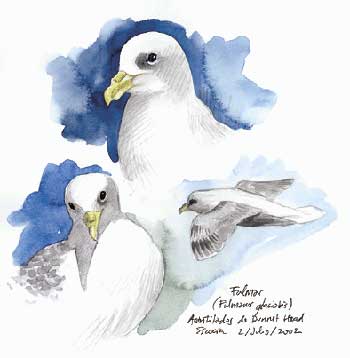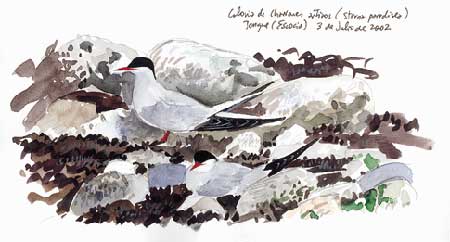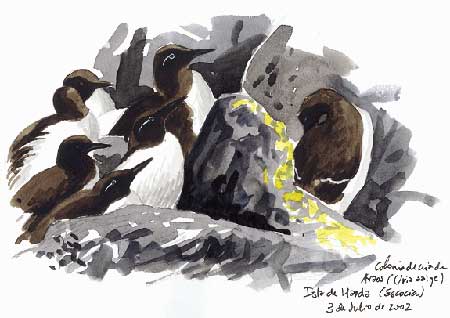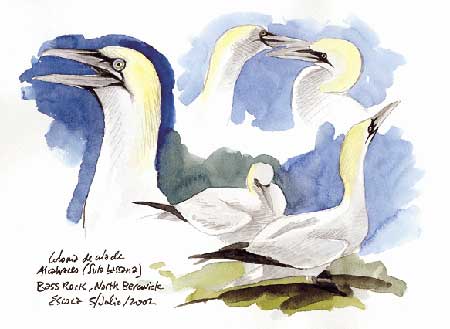|
SCOTLAND
By Jose Antonio Sencianes
Jose's Website |
 |
|
| Scotland is the paradise of the seabirds. Huge breeding colonies distribute themselves all along the Scottish coast. This is the reason why a visit to these cliffs becomes essential and rewarding for any ornithologist. |
| July 1 The northern end of British Islands is crowned by splendid cliffs. Dunnet Head is an excellent place to observe Puffins (Fratercula arctica), Razorbills (Alca torda) and many Atlantic Fulmars (Fulmarus glacialis), that delight us with acrobatics on the airflows which are raised by the walls of the cliff. They breed by the hundreds in very small sites where they deposit a single and round white egg. They allow close approach so that we can draw them at leisure. |
 |
| July 2 About 30 Kms. from Durness, is the locality of Tongue. In order to arrive here, it is necessary to cross a Firth. By 23:00 PM the low tide lets us see tens of Common Seals and Common Eiders (Somateria mollissima) resting on the sand. In the bouders, and perfectly camouflaged between pebbles we found a breeding colony of Arctic Terns (Sterna paradisea) that were very aggressive with us when we tried to photograph and draw them. |
 |
| July 3 One of the things that grab the attention in Scotland and especially in the Highlands is the lack of human presence. Thousand of hectares uninhabited, covered by thick layers of grass, and splashed by thousands of lakes. In one of them near one the Atlantic coast we could observe a pair with a chick of Black-throated Diver /Arctic Loon (Gavia arctica) |
 |
| July 4 The Island of Handa is an authentic ornithological paradise. Wild beaches, smooth prairies of grass that cover the cliffs. It is about 3kms. wide and that hosts the largest European colony of Guillemot (Uria aalge). They are a spectacular thing to see and we are lucky to have a day without rain. The numbers are moving: 60.000 pairs of Guillemot, 30,000 of Common Gull, 20,000 of Razorbill, 15,000 of Atlantic Fulmar, 10,000 of Puffins and 120 pairs of Arctic Skua. The swarm of thousands of "crowded together" birds, the frenetic activity, and the scent are things difficult to forget it. |
 |
| July 5 On the Eastern coast of Scotland, a few miles of North Berwick, is the Bass Rock, an impressive basalt barren island, where every year thousands of pairs of Gannets (Sula bassana) raise to breed. From a distance, the rock seems to be coverde by a snow layer, but as we get closer we smell the guano, and the activity of the colony startles all the passengers on the boat. We had the luck to disembark and to enjoy the imposing colony, where the birds hang above you while you take a walk among their nests. It is suprising how trusting the birds are, since they tolerate our so single presence to 1 meter of their nests. Aside from the Gannets, in the small barren island, there are also important numbers of Shags, Gulls, Guillemots and Razorbills.
Jose Antonio Sencianes Ortega
c/ MalasaÒa 38, 2A
29009 Malaga (ESPA—A)
Telf.: 952300801
Telf. movil: 654834327
|
 |
|






